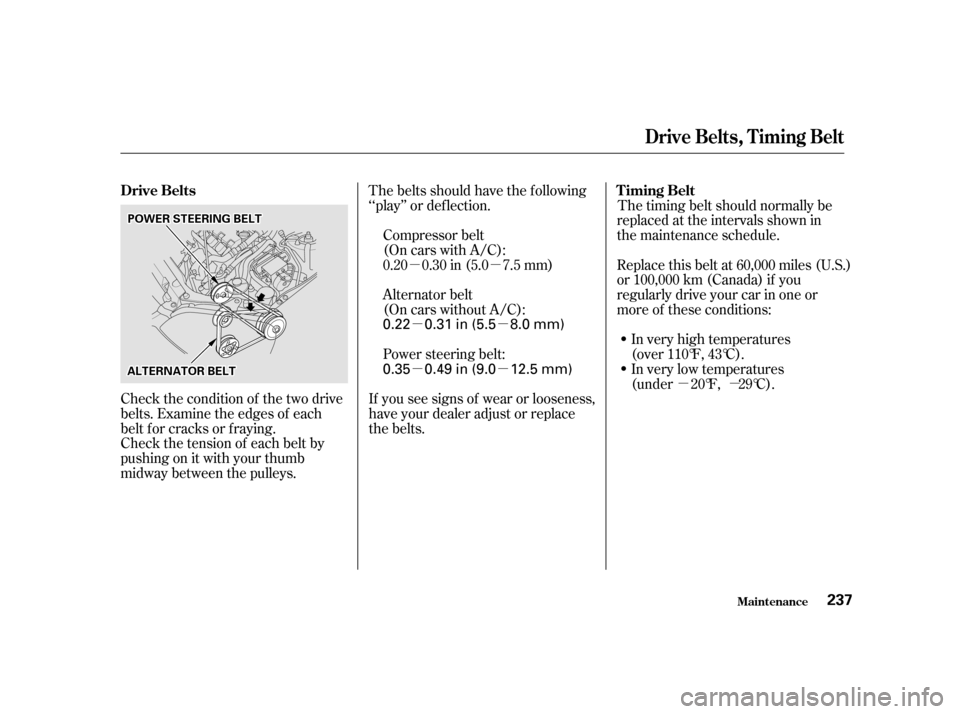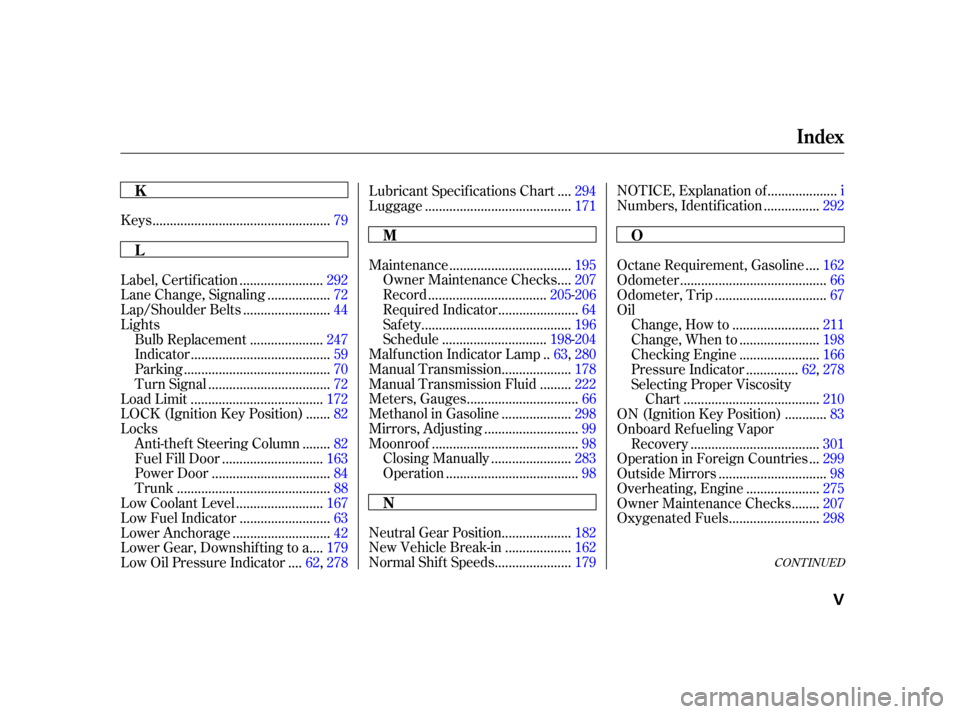Page 229 of 325
Clean the hood latch assembly with a
mild cleaner, then lubricate it with a
multipurpose grease. Lubricate all
the moving parts, including the pivot.
Follow the time and distance
recommendations in the
Maintenance Schedule. If you are
not sure how to clean and grease the
latch, contact your Honda dealer.
Maint enance
Hood L at ch
226
P PI
IVV O
OT TS
S
Page 230 of 325
The spark plugs in your car should
be replaced according to the time
and distance recommendations in
the maintenance schedule.Remove the cover by turning the
two clips one quarter turn
counterclockwise.
Clean up any dirt and oil that have
collected around the ignition coils.Use a wrench to remove the nut
holding the ignition coil. Remove
the ignition coil by pulling it
straight out.
Disconnect the wire connector
f rom the ignition coil by pushing
on the lock tab and pulling on the
connector. Pull on the plastic
connector, not the wires.
1.
2.
3.
4.
CONT INUED
Maint enance
Spark Plugs
Replacement
227
C CL
LIIPP S
S
Page 240 of 325

�µ�µ
�µ�µ �µ�µ
�µ�µ
Check the tension of each belt by
pushingonitwithyourthumb
midway between the pulleys. The belts should have the f ollowing
‘‘play’’ or def lection.
The timing belt should normally be
replaced at the intervals shown in
the maintenance schedule.
In very high temperatures
(over 110°F, 43°C).
In very low temperatures
(under 20°F, 29°C).
Replace this belt at 60,000 miles (U.S.)
or 100,000 km (Canada) if you
regularly drive your car in one or
more of these conditions:
Check the condition of the two drive
belts. Examine the edges of each
belt f or cracks or f raying. Power steering belt: Alternator belt
(On cars without A/C): Compressor belt
(On cars with A/C):
If you see signs of wear or looseness,
have your dealer adjust or replace
the belts. 0.20 0.30 in (5.0 7.5 mm)
Drive Belts
T iming Belt
Drive Belts, Timing Belt
Maint enance237
A AL
LTT E
ER
RN NA AT
TO
OR R B
BEEL
LTT
P
P
O
OW WE ER
R S
STTE
EE
ER
RI INNG G B
BEEL
LTT0.35 0.49 in (9.0 12.5 mm) 0.22 0.31 in (5.5 8.0 mm)
Page 257 of 325

Block the rear wheels.
Fill the f uel tank.
Change the engine oil and f ilter
(see page ).
Wash and dry the exterior
completely.
Cleantheinterior.Makesurethe
carpeting, floor mats, etc. are
completely dry.
Leave the parking brake off. Put
the transmission in Reverse
(5-speed manual) or Park
(automatic).
If you need to park your car f or an
extended period (more than one
month), there are several things you
should do to prepare it f or storage.
Proper preparation helps prevent
deterioration and makes it easier to
get your car back on the road. If
possible, store your car indoors.
If the car is to be stored for a
longer period, it should be
supported on jackstands so the
tires are of f the ground.
Leave one window open slightly (if
the car is being stored indoors).
Disconnect the battery.
Support the f ront wiper blade
arms with a f olded towel or rag so
they do not touch the windshield.
To minimize sticking, apply a
silicone spray lubricant to all door
and trunk seals. Also, apply a
vehiclebodywaxtothepainted
surfaces that mate with the door
and trunk seals.Coverthecarwitha‘‘breathable’’
cover, one made f rom a porous
material such as cotton.
Nonporous materials, such as
plastic sheeting, trap moisture,
which can damage the paint.
If possible, run the engine f or a
while periodically (pref erably once
amonth).
If you store your car f or 12 months
or longer, have your Honda dealer
perf orm the inspections called f or in
the24monthsmaintenanceschedule
(Normal Conditions) as soon as you
take it out of storage (see page ).
The replacements called f or in the
maintenance schedule are not
needed unless the car has actually
reached that time or mileage.
211
200
St oring Your Car
Maint enance254
Page 303 of 325

�Î�ÎIn Canada, Honda vehicles comply
with the Canadian Motor Vehicle
Saf ety Standards (CMVSS) f or
Emissions valid at the time they are
manuf actured. The United States Clean Air Act
sets standards f or automobile
emissions. It also requires that
automobile manufacturers explain to
owners how their emissions controls
workandwhattodotomaintain
them. This section summarizes how
the emissions controls work.
Scheduled maintenance is on page .
The burning of gasoline in your car’s
engine produces several byproducts.
Some of these are carbon monoxide
(CO), oxides of nitrogen (NOx) and
hydrocarbons (HC). Gasoline
evaporating from the tank also
produces hydrocarbons. Controlling
the production of NOx, CO, and HC
is important to the environment.
Under certain conditions of sunlight
and climate, NOx and HC react to
f orm photochemical ‘‘smog.’’ Carbon
monoxide does not contribute to
smog creation, but it is a poisonous
gas.
Your car has a Positive Crankcase
Ventilation System. This keeps
gasses that build up in the engine’s
crankcase from going into the
atmosphere. The Positive Crankcase
Ventilation valve routes them fromthe crankcase back to the intake
manif old. They are then drawn into
the engine and burned.
As gasoline evaporates in the f uel
tank, an evaporative emissions
control canister f illed with charcoal
adsorbs the vapor. It is stored in this
canister while the engine is of f . Af ter
the engine is started and warmed up,
the vapor is drawn into the engine
and burned during driving.
194
The Clean Air Act
Crankcase Emissions Control
System Evaporative Emissions Control
System
Emissions Cont rols
T echnical Inf ormation300
Page 320 of 325

CONT INUED
..................................................
Keys .79
...................
Neutral Gear Position . 182
..................
New Vehicle Break-in . 162
.....................
Normal Shif t Speeds .179 ...................
NOTICE, Explanation of . i
...............
Numbers, Identif ication . 292
..................................
Maintenance .195
...
Owner Maintenance Checks . 207
.................................
Record .205-206
......................
Required Indicator .64
..........................................
Saf ety .196
.............................
Schedule .198-204
.
Malf unction Indicator Lamp . 63,280
...................
Manual Transmission . 178
........
Manual Transmission Fluid . 222
...............................
Meters, Gauges .66
...................
Methanol in Gasoline . 298
..........................
Mirrors, Adjusting .99
.........................................
Moonroof .98
......................
Closing Manually .283
.....................................
Operation .98
.......................
Label, Certif ication .292
.................
Lane Change, Signaling . 72
........................
Lap/Shoulder Belts .44
Lights ....................
Bulb Replacement .247
.......................................
Indicator .59
.........................................
Parking .70
..................................
Turn Signal .72
.....................................
Load Limit .172
......
LOCK (Ignition Key Position) . 82
Locks .......
Anti-thef t Steering Column . 82
............................
Fuel Fill Door .163
.................................
Power Door .84
...........................................
Trunk .88
........................
Low Coolant Level .167
.........................
Low Fuel Indicator .63
...........................
Lower Anchorage .42
...
Lower Gear, Downshif ting to a . 179
...
Low Oil Pressure Indicator . 62,278 ...
Lubricant Specif ications Chart . 294
.........................................
Luggage .171
...
Octane Requirement, Gasoline . 162
.........................................
Odometer .66
...............................
Odometer, Trip .67
Oil ........................
Change, How to .211
......................
Change, When to .198
......................
Checking Engine .166
..............
Pressure Indicator . 62,278
Selecting Proper Viscosity ......................................
Chart .210
...........
ON (Ignition Key Position) . 83
Onboard Ref ueling Vapor ....................................
Recovery .301
..
Operation in Foreign Countries . 299
..............................
Outside Mirrors .98
....................
Overheating, Engine .275
.......
Owner Maintenance Checks . 207
.........................
Oxygenated Fuels .298
Index
L M
NO
K
V